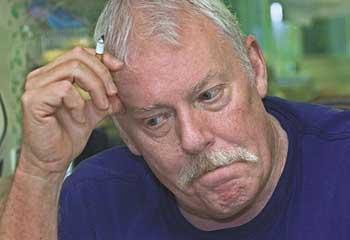Sterling New Doc on AWOL MIA McKinley Nolan

It’s a safe bet that just about every American who took part in the Vietnam War heard tell during his or her tour about a renegade G.I., usually an African-American, living among, and fighting for, the Viet Cong. Those stories had the taste, feel and smell (metaphorically speaking) of urban legends, Vietnam War style.
On the other hand, it turns out that there is compelling evidence that at least one black American solider, McKinley Nolan (above ), did go over to the other side in 1967. Nolan, who grew up in a rural area of Texas, joined the Army in 1965, a year after he got married. He went AWOL in Vietnam sometime in 1967, and reports soon surfaced that he joined a VC unit, married a Vietnamese woman, and that they had a child.
Nolan’s trail went cold until 1973 when reports surfaced that he and his Vietnamese family were living with the Khmer Rouge in Cambodia. The trail went colder still in 1977 during the Cambodian Holocaust when McKinley Nolan and his family disappeared near Chamkar Caffee Village in Cambodia. His American wife Mary and the rest of his family has not heard anything from him, or from the U.S. military or government, in all those years.

In 2005, Vietnam veteran Dan Smith on a trip back to the former war zone, ran into an African-American man in his age bracket in Tay Ninh City. When Smith (above ) asked the man his name, he mumbled something that Smith believes was “McKinley Nolan, ” and then disappeared. That brief chance encounter opens the new riveting, intriguing documentary The Disappearance of McKinley Nolan (Corra Films), which is making the rounds—and winning accolades—at film festivals across the nation.
The film, directed by Henry Corra, begins with Smith, who was seriously wounded in Vietnam and also suffered emotionally after his tour of duty, relating the tale of the strange meeting in Tay Ninh. Then Corra’s cameras capture Smith’s emotionally charged visit to McKinley Nolan’s wife Mary and other members of his family in the spring of 2007 in Washington-on-Brazos, Texas.
The story then moves to October 2008 when Corra (a protégé of the great documentary filmmakers David and Albert Maysles) and company accompanied Smith and McKinley’s brother Michael on a trip to Vietnam and Cambodia. Corra’s entourage included a translator and the journalist and author Richard Linnett (The Eagle Mutiny ), who had been following the McKinley Nolan story for a decade.
Linnett “told me that Lt. Dan Smith was traveling to Texas to tell the Nolan family of his recent sighting of McKinley in Vietnam, ” Corra says on the film’s website. “I asked if I could be there with my camera. Immediately when I first met Smith and the Nolans a bell went off in my head where I knew we were about to embark on a life-changing journey together.”
The heart of that journey took place during the Vietnam-Cambodia trip. In Vietnam, the family met several former Viet Cong, who told them tales of their brother, including, they said, the fact that he killed two or three MP’s before he went over to their side. The Americans also met McKinley’s Nolan’s stepson, a Vietnamese man, who accompanied the group to Cambodia.
In Cambodia, Smith, Michael Nolan and company found several former Khmer Rouge fighters who knew Nolan and his Vietnamese wife. The Americans then went to the remote area where Nolan and his Vietnamese family were last seen in 1977. After talking to the Cambodians, the Americans were all but convinced that McKinley Nolan, his Vietnamese wife and their child were killed by the Khmer Rouge during the time of the Cambodian “Killing Fields.”
One of the most arresting scenes in the film is the site of a Joint POW-MIA Accounting Command helicopter descending under Michael Nolan’s watchful eye in January 2009 at a recovery site set up by JPAC where they believed McKinley Nolan was killed. The fact that this occurred certainly was the result of the family’s visit in September 2008 with their member of Congress. Rep. Sheila Jackson Lee of Texas, who told Mary and Michael Nolan that she would get on the case. Corra captures the scene in Jackson Lee’s office very well.
The Disappearance of McKinley Nolan is a first-rate production. The cameras bore in on the faces of the film’s players relentlessly and effectively. The story spins out slowly and picks up steam every step of the way.
My only problem, a relatively minor one, was Corra’s use of war-time footage to give the story more heft. Too often, he chose images that didn’t fit the narrative—-most egregiously, two iconic pieces of film, ARVN Gen. Loan’s execution of a VC prisoner on the street in Saigon during Tet of ’68, and the shots of recently napalmed South Vietnamese children. Most of the other war-time footage fits into the narrative; those two did not.
Aside from that small misstep, The Disappearance of McKinley is a superb documentary that deserves to be widely seen.

